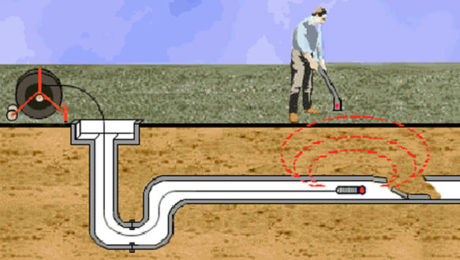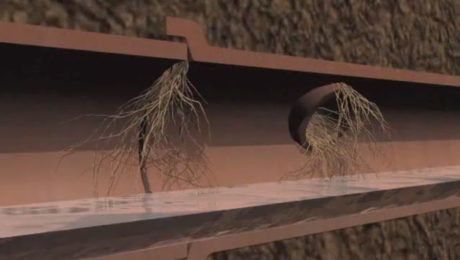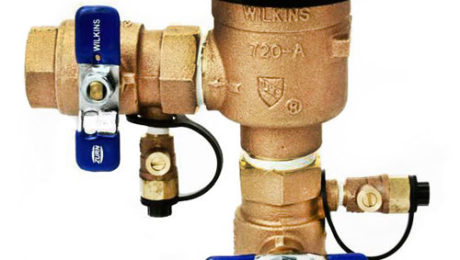Drain Lines…Camera…Action
We’ve come a long way since the days of physically digging up plumbing pipes in order to locate a problem. Today, inspections are done with a video line camera which provides a visual inspection of sewer lines or other underground pipes located in cement or under the foundation.
This specialized camera sits at the end of a flexible rod. The rod travels through pipes, providing real-time video image transmission. The camera records the physical location and depth of any blockage, corrosion, grease buildup, leaks, and broken or collapsed pipes.
If you notice you have repeated drain line backups, slow drains or frequent clogs, an inspection is a good idea. Pinpointing the problem area saves you from having to unnecessarily replace pipes. Inspections can also be helpful in finding valuables that may have slipped down the drain.
Once the problem has been identified, there are generally two solutions. For cleaning out sludge and debris buildup, a process called Hydro Jetting uses high speed / high pressure water to clear blockages in pipe systems.
For broken or collapsed lines that need to be replaced, the camera makes locating the pipe much easier, resulting in a faster repair process. Once the service has been performed, repeat the camera line inspection to be sure the problem is fixed.
Recorded images can be saved for permanent records. It’s also a good idea to have an inspection done before buying a home to ensure there are no major problems.
If you suspect a problem, or need an inspection for other reasons, give us a call. All Pro Plumbing Services are available in Osceola County, Seminole County and Orange County, Florida.
- Published in Tips of the Trade
Nature vs. Plumbing
The unfortunate reality is that nature can wreak havoc on you’re plumbing system. The good news is that with regular maintenance and inspection, you can prevent damage or at least minimize the problem.
Roots
Known as “root intrusion” the name is fitting for one of the biggest culprits of broken pipes. Your sewage drainage system is crucial to the overall functionality so keeping it maintained will save you from costly repairs.
Generally, visible roots are only a portion of the entire root. Even a small puncture allows roots to grow through and obstruct the pipe. In Orlando and Central Florida, we have a high water table making it easier for the roots to seek out the water source. If you notice a slow in water flow, or if multiple fixtures such as the toilet, sink or shower start backing up, most likely you will need to repair or replace a pipe. This should be done by a professional plumber. Cleaning the interior with chemical or herbicide treatments is a temporary fix and won’t solve the real problem. Also, some of the treatments are illegal and can carry large fines.
Lightning
It’s rare to associate lightning with plumbing issues, but it’s a real concern. Especially in Central Florida which has ten times as many lightning strikes as the rest of the country. When lightning strikes the water distribution systems, it can cause pinhole leaks and sometimes even burst the pipes, costing thousands of dollars in uninsured plumbing repairs.
The theory is that lightning sends electricity shooting through the ground when it strikes. It seeks out buried, copper pipes or the home’s ground rod. It moves through the pipe until it reaches a dead end, usually at a plastic junction. The electricity needs an outlet, so the charge jumps from copper to water leaving a hole in the pipe.
To keep abreast of any damage, it’s wise to do a visual check for leaks by inspecting all appliances and fixtures that need plumbing. If you find a leak, get a professional pressure test and repair even small leaks before they get worse.
Warm Weather
Heat is also damaging to your pipes. When the ground dries out from lack of rain, it causes the house to settle which can cause your water main to crack or leak. Ultraviolet Rays can also damage exposed pipes so be sure to cover them with insulation.
Buried pipes have an increased water pressure which adds strain to the pipeline walls. Older pipes are often made of concrete making them more susceptible to breakage.
It’s important to keep the ground as moist as possible, however, with the increasing need for water conservation, watering around the foundation is most important.
If you suspect damage, call All Pro, we’ll find the cause and fix the problem.
- Published in Tips of the Trade
Beating Backflow
When it comes to plumbing systems, there are a lot of things we take for granted- clean water being one of them. But this necessity isn’t a given. Contaminated water can enter your private water system, or even worse, the municipal system. Fortunately, there’s a stop-gate for that— literally.
Here’s how it works. Water should be a one-way flow, but when normal water pressure drops from things like a water line breaking, or a fire hydrant being used, causes the pressure to drop which reverses the supply water sucking contaminated water back into the system. This can happen from any source that is cross-connected such as toilets, dishwashers, washing machines and sprinkler systems. A backflow devise protects your home from this happening. If the water is flowing in one direction, the backflow devise remains open. If the water flow is reversed, the backflow device creates a physical barrier to stop the contaminated water from entering.
There are three main types of backflow devices:
• Reduced Pressure Principle Assembly. This device is best for major hazard applications. It’s the most complex and therefore more expensive, but it’s the most reliable and secure.
• Pressure Vacuum Breaker Assembly. This is the most common whole-system backflow device used most often for irrigation sprinkler systems.
- Atmospheric Vacuum Breaker Assembly: This inexpensive device is used for single fixture applications such as toilets, urinals, and some faucets.
• Double Check Valve Assembly: This device is used for underground or in-line installations, meaning, the devise runs parallel with the piping of your sprinkler system.
Fresh water isn’t something to reckon with, so there is also a second line of defense, the Dual Check Valve, which controls the backup at the cross-connection point.
For new construction, ALL PRO Plumbing can help you figure out the best solution for your needs. For existing systems, it’s important to have the devices tested periodically. Because of the moving parts including internal seals and springs, a lot of wear and tear can occur.
- Published in Tips of the Trade
Plumbing Problem Prevention
Face it, it’s easy to ignore your plumbing system until something goes wrong. Really easy. But taking the time to check your system can keep problems at bay, saving you a lot of time, money and hassle. So roll up your sleeves, don the rubber gloves and get to work.
Drain your water heater. Keeping your water heater clean isn’t hard, but it is important. First, turn off the power and/or gas supply to the water heater.To drain, attach a hose and drain the water into a bucket. Briefly turn on the cold water valve, which will stir up the sediment. Drain again and repeat until the water comes out clean.
Check your drains. Clogged drains can be a real mess, so do a once-over to see if you suspect one coming your way. Is there a lingering smell? Does it drain slowly? Does it get clogged frequently? If so, either shut off the valves and open up the pipes to clean them, or call a plumber. Liquid drain cleaners aren’t recommended since they can erode the pipes and make clogs worse.
Clean the toilet tank. Yes, we said the tank. Doing so can extend the lifespan of your toilet. Standing water brings about mold, and debris can erode the rubber on the plunger and flapper. To clean, turn off the water and flush the toilet. Mix 1/4 white vinegar with 1 c. water and scrub. We don’t recommend toilet tabs because they contain bleach which can erode the parts. Either way, always wear gloves.
Check for leaks. For the toilet, put a few drops of food coloring in the tank. Wait 10 minutes, and if the color leaks into the bowl, you have a leak. If you see your faucets and showerheads dripping, don’t wait to fix them. You would be surprised at how much water (and money) is wasted through drips.
Some of these suggestions can be easily handled, but if you don’t trust your skills, call an expert for a plumbing inspection. Trite as it sounds, an ounce of prevention is worth a pound of cure!
- Published in Tips of the Trade




